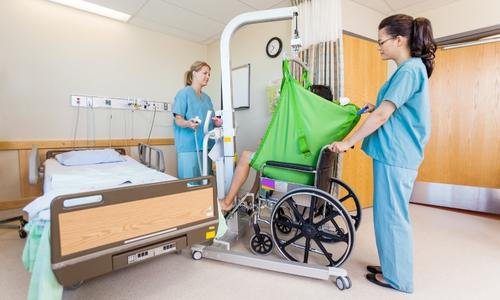What Are the Main Types of Hoyer Lift Slings?
When you go to buy a Hoyer patient lift for someone with limited mobility, you will need to purchase patient lift slings separately to use with the machine. Lifting slings don't usually come with lift equipment automatically because the slings need to be matched to the size and weight capacity of the patient, as well as matching the intended use of the lift, such as:
Transfer between surfaces
Transfer from sitting to standing
Bathing and toileting
While “Hoyer lift” is often used as a generic term to describe patient lifts in general, we’ll focus here on Hoyer-brand patient lift sling models and types.
Types of Hoyer Lift Slings
The following are among the most common types of Hoyer lift slings you’ll encounter.
Full-Back Slings
Full-back slings offer the most support for patients with certain spinal cord injuries or limited upper-body strength. Extending right up past the patient's head, these slings offer neck support, head support, and shoulder support for a safe transfer between surfaces like a rental hospital bed, power chair, or transport chair. With a full-back sling, the patient is in a sitting position while being hoisted by the patient lift, angled slightly backward to prevent him or her from falling out of the sling.
Full-Back Hoyer Lift Slings
Hoyer Full Back 4-Point Padded Lift Sling
Hoyer 6-Point Full Back Padded Bariatric Lift Sling
Hoyer Full Back 4-Point Net Sling
Hoyer Disposable 4-Point Lift Sling - Comfort and Full Back (for use with a single patient)
U-Shape Slings
U-shape slings also maintain the patient in a seated position but usually don't support the neck or head. The inverse "arms" of the U wrap around the underside of the patient's thighs while the wider curve supports their back. Most universal slings are designed in an inverse U shape. U slings are ideal for patients with neck strength who need assistance to transfer between chairs or from a bed to a chair and vice versa. Both 4-point and 6-point slings are available.
U-Shape Hoyer Lift Slings
Universal Hoyer 4-Point Padded U-Slings
Padded U-Sling
Slings with a Commode Opening
Toileting or commode models feature a one-piece contour sling design with support for the buttocks and a commode opening to facilitate toileting while protecting patient dignity. These slings are ideal for amputees who cannot use a U-shape design.
In the Hoyer range, patient slings with a commode opening come in 2-point and 6-point cradle options, with or without chains, and are made from polydura or dacron. Dacron is a popular choice because it’s lightweight but still rigid and flexible. As these sling types are hygiene products, each sling should only be used with a single patient.
Hoyer Commode Slings
Hoyer Sling with Commode Opening
Hoyer One Piece Commode Lift 4-Point Sling with Positioning Strap
Hoyer Loop Style Long Seat Commode 6-point Slings
For stronger patients who don't need full-back support, consider a:
Hoyer 6-Point Access Toileting Lift Sling
Bathing Slings
In the Hoyer range, there are patient lift slings that are designed to allow a caregiver to bathe the patient while he or she is supported by the sling (in a chair or in the bathtub). These slings feature a quick-draining mesh construction made from waterproof nylon.
Depending on the patient's strength and specific needs, bathing slings are available with or without head support and come in a range of sizes. Most patient lifts will allow you to either shower or bathe a patient when used with the appropriate sling.
Hoyer Bathing Slings
Universal Hoyer Nylon Mesh Bath Lift 4-Point Sling
Bariatric Slings
For heavier patients, X-large bariatric slings are available with padding for added comfort and a durable, stretch-resistant polyester or mesh construction. Be sure to check the weight capacity and size indications before purchase to ensure the appropriate sling for the patient.
Hoyer Bariatric Slings
Hoyer 6-Point Full Back Padded Bariatric Lift Sling
Hoyer Pro 6-Point Quickfit Bariatric Slings
Sit-to-Stand Slings
Patients who can sit upright without assistance and bear 25% to 75% of their own body weight may be able to use a sit-to-stand lift, which functions somewhat like a recliner lift chair. Once standing, the patient can transfer to a mobility aid for walking and the sling and harnesses can be removed.
Compared to full-back or U-shape slings, stand-aid slings are much smaller and generally consist of a wide section that supports the lower back and two hanging arms that support the thighs. The main features to look for in a sit-to-stand sling are padding for comfort and non-slip fabric for safety.
Hoyer Stand-Aid Slings
Hoyer Deluxe Transport Lift Sling
Deluxe 2-Point Stand-Aid Sling for Hoyer Lifts
Features to Ask About
When choosing between the different types of Hoyer lift slings, be sure to pay attention to:
The size
The weight capacity
The compatible patient lift models
The amount of support needed for the patient's body
Safety features like positioning straps, chains, and non-slip fabric
In addition, make sure that you receive thorough training from an expert staff member and a physical therapist in the safe use of Hoyer lift slings and other mobility equipment you intend to use with a patient, including hospital beds, power chairs, and recliner lift chairs.
Finally, remember to ask about any offers that come with the purchase, such as free shipping within your city, home installation, and returns. Many mobility equipment suppliers, such as Mobility Plus in Denver, Colorado, include delivery within a specified area and can calculate delivery costs outside of that area on request.
The Right Sling Makes a World of Difference
Being aware of the different types of Hoyer lift slings and how to choose the right sling for each patient's needs are the keys to caregiver and patient or resident safety, comfort, dignity, and efficiency.
If you would like more assistance with choosing a lift sling, it’s best to consult with a physical therapist or mobility specialist for personalized advice.

